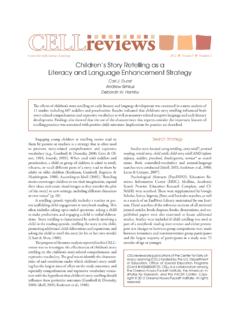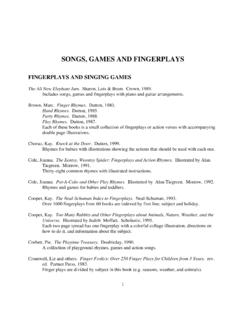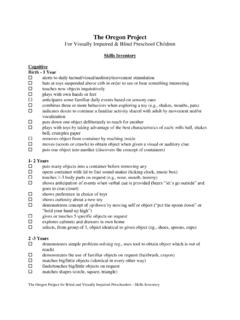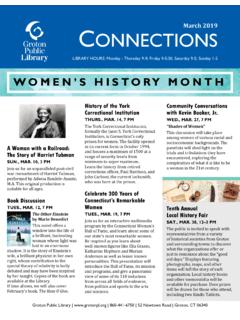Transcription of Especially for parents of toddlers! Toddler Fingerplays ...
1 Enjoy Fingerplays and action rhymes often with your Toddler . He ll look forward to these times with you, playing with language and moving his body. You can play them while waiting for a table at a restaurant. Or play while watching a brother s soccer game or with friends who come to visit. You can find ideas on the Internet by searching Fingerplays and action rhymes. You can also have great fun inventing your own! Fingerplays and action rhymes can be about any subject that interests your Toddler (dolls, animals, firefighters, food, etc.). The sillier the rhymes are, the more she will want to do them again and again. If the fingerplay or action rhyme is a new one, teach it with pleasure. It doesn t matter if you get it right your enjoyment will inspire your child! Repeat the fingerplay or action rhyme slowly. Help your Toddler make the finger or hand Fingerplays and Action RhymesWhat is the practice?What does the practice look like?
2 How do you do the practice?How do you knowthe practice worked?pracctie sCELLCENTER for EARLY LITERACY LEARNINGE specially for parents of toddlers! Toddlers find it fun and exciting to explore the world of language while moving their fingers, arms, and bodies. Fingerplays and action rhymes can help toddlers build word skills and add new words they know and use. These important early literacy activities spice up language learning with fun! Fingerplays and action rhymes are brief stories often with rhymes that are paired with finger or body motions. Fingerplays and action rhymes help toddlers learn about rhyming words and poetry. They get toddlers to listen, speak, and pair words with actions. Sometimes your Toddler says a rhyme and uses her fingers, hands, or body to act it out. When she does these things, she is playing a fingerplay or action rhyme. The Eensy-Weensy Spider is an example of a fingerplay. You start the fingerplay or action rhyme.
3 Ask your Toddler to join in if she has not already started saying the words. Let your Toddler lead the fingerplay or action rhyme as much as possible, even if she makes mistakes. Let her lead, and watch how proud she is! Trying new Fingerplays or action rhymes is fun for your tod-dler, but don t forget the old favorites. Repeated play is important for learning. Be sure to keep playing familiar Fingerplays or action rhymes along with new ones. Encourage your Toddler to try Fingerplays and action rhymes. Smile and comment on her successes. Your par-ticipation and interest will go a long way in keeping your Toddler involved. Does your Toddler do Fingerplays or action rhymes more often? Is your Toddler enjoying doing Fingerplays or action rhymes? Does your Toddler try to make up her own Fingerplays or action rhymes?Rhymes and Sound Awareness CELLMore introducing Fingerplays and action rhymesEensy-Weensy SpiderAction-Rhyme Rowing There was a little Maya, 23 months of age, is a powerhouse of energy.
4 Maya s mom decided doing an action rhyme like Row, Row, Row Your Boat would be something Miss Energy would enjoy. She asked Maya to sit facing her, on her lap, so that they could hold hands. Mom showed Maya how to lean forward as she pulled Maya forward. How to lean back and pull her mom toward her. They did the motion a few times. Then Ma-ya s mom began to sing Row, Row, Row Your Boat in time to their rocking. When they finished, Maya wanted to do it again and again!At 18 months, Sophia had never done a fingerplay. Knowing that Sophia was always waving her arms, Mom decided to teach one. As Sophia waved her arms, Mom took her into her lap. She snuggled Sophia and placed her arm around her. Mom began to sing Eensy-Weensy Spider and move Sophia s hands to make the motions. After she finished, she waited to see Sophia s reaction; Sophia smiled up at her mom and moved her arms. Mom began the song again, doing the motions with Sophia s hands.
5 By the third time through, Sophia was trying to do the motions on her own. She showed clearly how much she enjoyed it and wanted to continue is a Toddler who has a hard time sitting still while listening to books or songs. Her mom knows how much Kara loves her pet turtle. She finds a fingerplay about a turtle on the Internet (There Was a Little Turtle Who Lived in a Box). She recites it to Kara every day while Kara feeds or plays with her pet. She even changes the words to include the turtle s name. Once Kara is famil-iar with the rhyme, she begins trying the motions. Kara loves pretending to snap at fleas and mosquitoes with her fingers. Soon she can recite the rhyme. Along with her mom, she does the motions. Sometimes she even stresses the rhyming words at the end of each line!CELL practices Is a publication of the Center for Early Literacy Learning (CELL), funded by the Department of Education, Office of Special Education Programs (H326B060010).
6 The opinions expressed, however, are those of CELL and not necessarily those of the Department of Education. Copyright 2010 by the Orelena Hawks Puckett Institute, Asheville, North Carolina ( ).Rhymes and Sound AwarenessMovin and Groovin Nursery RhymesWhat is the practice?What does the practice look like?How do you do the practice?How do you knowthe practice worked?pracctie sCELLCENTER for EARLY LITERACY LEARNINGE specially for parents of toddlers! The chants and body movements of action rhymes promote the development of speech and listening skills. Young toddlers often engage in action rhymes with a parent or other rhymes are short rhymes either sung or spoken that are matched with body movement to tell a story. An example of an action rhyme is Ring Around the Rosies. Walking in a circle with big brother and sister and falling down at We all fall down is great fun. You can find action rhymes that help toddlers build word skills by searching the Web.
7 A good term to search is action rhymes. To help you make up your own action rhymes, search with the term rhyming words for fun practice guide Fingerplays All the Way offers some suggestions about how to introduce action rhymes to your Toddler . Using action rhymes about topics of interest to your child is an important starting point. The following are a few examples of action rhymes your Toddler might enjoy: Little, Bigger, BiggestA little ball, (Make a ball with finger and thumb.)A bigger ball, (Make a ball with two hands.)And a great big ball. (Make a ball with arms.)Now help me count , Two, Three! (Repeat gestures for each size.) Does your Toddler participate more in ac-tion rhymes? Is your Toddler smiling and laughing while doing the action rhyme? Does your Toddler try to change or make up new action rhymes?Row Your BoatRow, row, row your boatGently down the , Merrily, Merrily, Merrily,Life is but a dream.(Sitting on the floor with your child, hold his or her hands and rock backward and forward.)
8 StretchingWhen I stretch up, I feel so tall. (Reach high.)When I bend down, I feel so small. (Bend over.)Taller, Taller, Taller, Taller. (Reach up high.)Smaller, Smaller, Smaller, Smaller. (Get low on the floor.)Into a tiny Around the RosiesRing around the pocket full of posies. (Hold hands and go around in a circle for the first two lines.)Ashes, ashes, we all fall down! (Fall to the ground.)Exploring the world of language while getting to move their bodies is exciting for most toddlers. Action rhymes rhymes paired with body movements are fun. They give toddlers opportunities to learn new words and phrases while matching them with physical a look at more action rhymes for toddlersFun with RhymingCalming Action RhymesIt s a Stretch!Sometimes going to bed isn t easy. Peter s dad has found that calming action rhymes help his 30-month-old Toddler settle down. Dad makes up a rhyme for bed time.
9 Dad says, Time for bed, time for bed, and Peter crawls onto the bed. Fluff up your pillow, and he pushes on his pillow. Lay down your head, and down goes the head. Pull up the blanket, he pulls up the cover. Tuck in tight, Dad makes sure the covers are up. Close your eyes and sleep all night! Dad knows Peter enjoys the rhymes, actions, and settling effect of the routine because he asks for it every Sadie always enjoys jumping and running around, so action rhymes are fun for her. She and her dad do the motions together and take turns being the leader. Dad starts with Stand up tall and they both stretch up high. Get down small and they drop to the floor in a ball. Then Sadie takes a turn and calls, Run to the hall! They both take off running to the hall. The back-and-forth directions continue with words rhyming with ball, like call, hall, small, tall, fall, crawl, and wall. Sadie loves playing the game and begins to make up nonsense words that , a Toddler with moderate motor impairment, loves to sing and dance to his favorite children s songs.
10 When Heads, Shoulders, Knees and Toes starts, Raza loves the rhymes and trys to touch the correct body parts. Big brother Sahil stands behind him and helps move Raza s arms to touch the right parts at the right time. Sometimes they both get lost going too fast, which makes them laugh. Sometimes Sahil tries to get Raza to do the motions wrong, and he cheers when Raza catches the mistake. They both sing the song, and Raza moves more easily as his muscles strengthen and stretch. CELL practices Is a publication of the Center for Early Literacy Learning (CELL), funded by the Department of Education, Office of Special Education Programs (H326B060010). The opinions expressed, however, are those of CELL and not necessarily those of the Department of Education. Copyright 2010 by the Orelena Hawks Puckett Institute, Asheville, North Carolina ( ). Toddler Rhymes and RhythmWhat is the practice?












